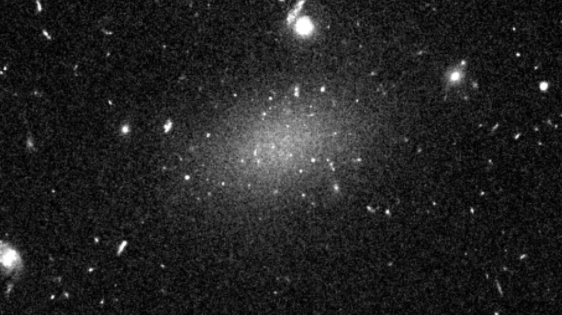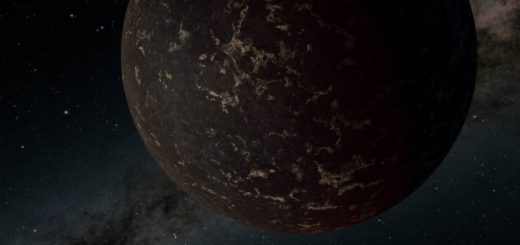Astronomers claimed galaxy was 98% dark matter. They were wrong.

Back in 2016, researchers claimed to have found a galaxy made almost completely of dark matter and almost no stars. Now, on closer examination, that claim has fallen apart.
The galaxy, Dragonfly 44 (DF44), belongs to a class of mysterious objects known as ultra-diffuse galaxies or UDGs. Researchers have debated since the 1980s whether these vast, dim objects have a low mass, like dwarf galaxies smeared across huge reaches of space, or more like heavy, Milky Way-style galaxies that seem dim for two reasons: because they have almost no stars, and because a huge fraction of their mass is dark matter found in the outer fringes of the galaxy, in so-called dark matter haloes that emit no light. In a paper published in 2016 in The Astrophysical Journal Letters, scientists argued that DF44 was one of these galaxies with a big dark matter halo and few stars. They estimated its mass and found it was at least 98% dark matter.
But a new analysis, published Oct. 8 in the journal Monthly Notices of the Royal Astronomical Society, suggests the earlier study got it wrong. Researchers in the 2016 study assumed a bunch of mass was globbed into the dark matter halo; but actually, the new study showed a much lower total mass, indicating DF44 is one of those low-mass dwarf galaxies spread across space with normal percentages of dark matter.
DF44 is about 360 million light-years from Earth, so astronomers can’t directly measure its mass. Instead, they rely on proxies. Features like the speed at which objects circle a galaxy can indicate how massive it really is, as more gravity would cause objects to whirl faster.
In 2016, researchers claimed DF44 had a huge halo because of how fast its globular clusters (the few that call the galaxy home) seemed to be whirling around its center. (Globular clusters are blobby groups of stars that accumulate around galaxies.) But those velocity measurements turned out in 2019 to be incorrect
However, that wasn’t the end of the argument that DF44 had a huge amount of dark matter. That’s because the galaxy did seem to host a relatively high number of globular clusters.
Over time, researchers have noticed a general relationship between the number of globular clusters in a galaxy and that galaxy’s mass, said the new study’s lead author Teymoor Saifollahi, a doctoral candidate at the University of Groningen in the Netherlands.
And DF44 did seem to have a more globular clusters than you’d expect for a galaxy with so few stars. Early observations estimated about 100 of these clusters, which was later narrowed down to 80 in a 2017 paper in the Astrophysical Journal Letters. That would put the mass of DF44 squarely in Milky Way territory — a jarring result, with huge implications for how cosmologists understand the history of galaxy formation across space-time. Galaxies, in the new model, would be primarily dark matter objects, able to form without many stars or other luminous matter at all. All those bright dots in space would just be optional accessories.
Saifollahi and his colleagues did their own count, however, and they landed on a much lower number: 20. That would indicate that DF44 has a normal, dwarf galaxy mass — a much less exciting result.
It’s not surprising that the two research teams ended up with such different counts, he said.
Why such a stark difference in estimates?
“It is not as easy as just looking and counting,” Saifollahi told Live Science. “In the images, there are all sort[s] of astronomical objects, and not all of them are globular clusters. Some are just stars in the middle of the way from us to the galaxy, and some are very far objects which look small.”
There’s always some level of uncertainty in figuring out what those objects are, he said. That’s especially true when you take into account that researchers assume globular clusters too small and dim to see from our vantage point always exist around any galaxy.
The key difference between the 2017 analysis and the 2020 analysis, Saifollahi said, has to do with where they assumed most globular clusters inDF44 were located. The 2017 team made a rough guess as to how far the clusters would orbit from the center of the galaxy, based on standard numbers associated with dwarf galaxies, and then looked for candidates in that area. For the 2020 paper, the researchers actually measured how far the clusters extended from the center of the galaxy, and found that the stellar globs clustered much closer to DF44’s center than expected. Counting possible clusters only in that smaller area produced a smaller number
“This is also an interesting finding on the side,” he said.
In future studies of UDGs, he said, scientists will have to be more careful not to rely on standard assumptions about globular clusters. He and his colleagues plan to more closely examine other UDGs that have high estimated numbers of globular clusters, and see if those estimates hold up.



 Creators of mankind
Creators of mankind Description of “Tall white aliens”
Description of “Tall white aliens” Where they came from?
Where they came from? About hostile civilizations
About hostile civilizations The war for the Earth
The war for the Earth “Tall white aliens” about eternal life
“Tall white aliens” about eternal life Video: “Nordic aliens”
Video: “Nordic aliens” Aliens
Aliens Alien encounters
Alien encounters The aliens base
The aliens base UFO
UFO Technology UFO
Technology UFO Underground civilization
Underground civilization Ancient alien artifacts
Ancient alien artifacts Military and UFO
Military and UFO Mysteries and hypotheses
Mysteries and hypotheses Scientific facts
Scientific facts


















